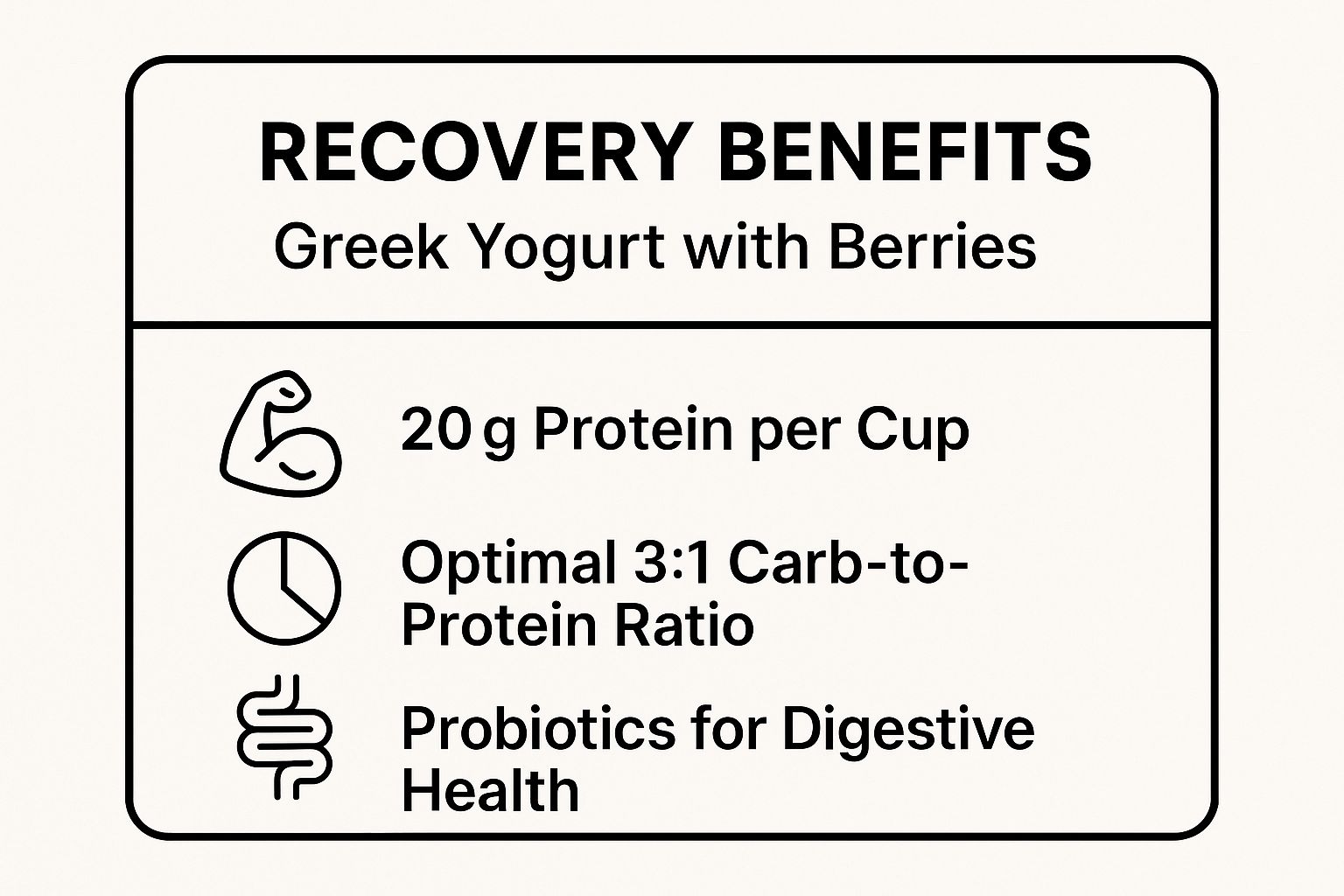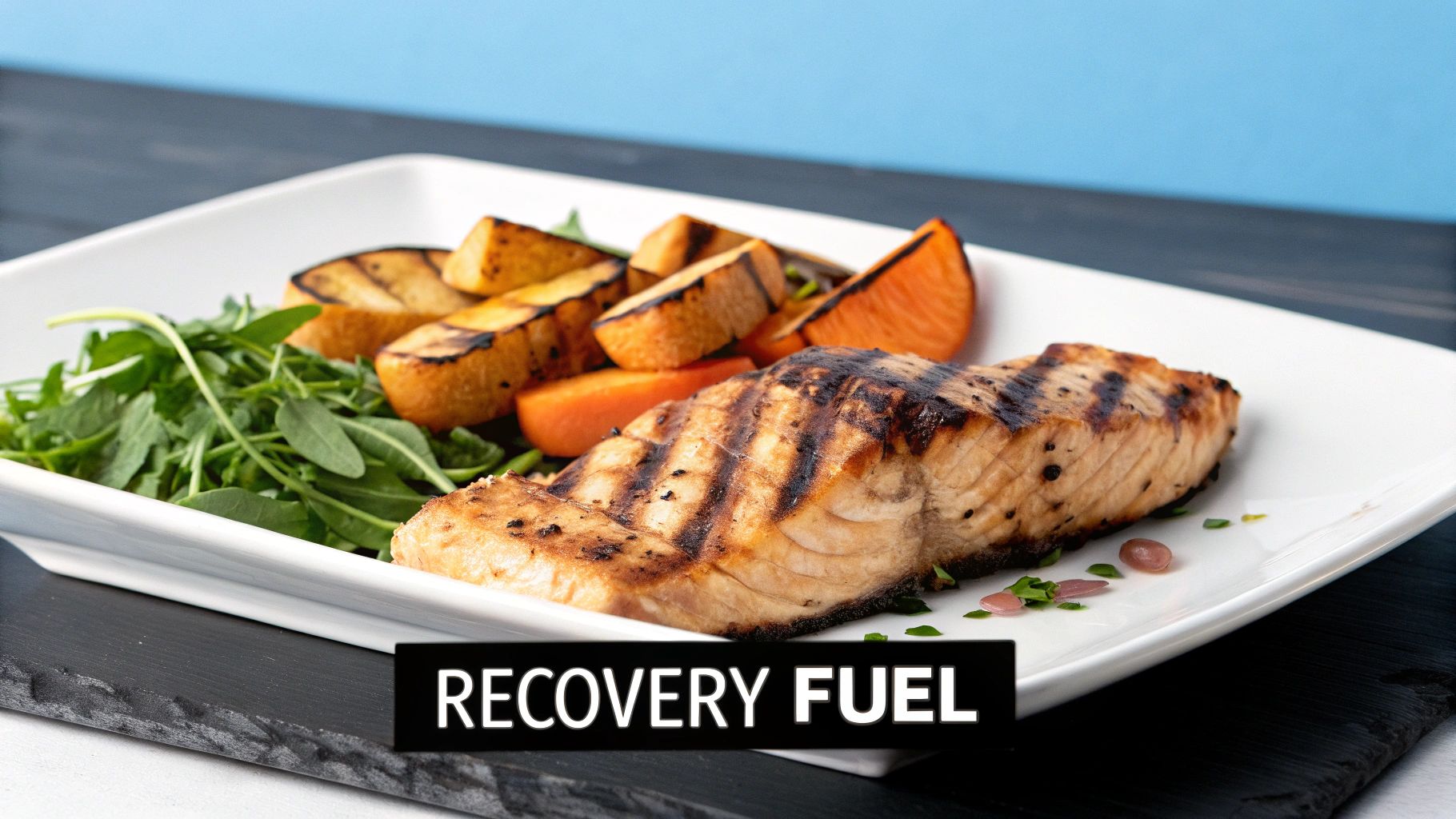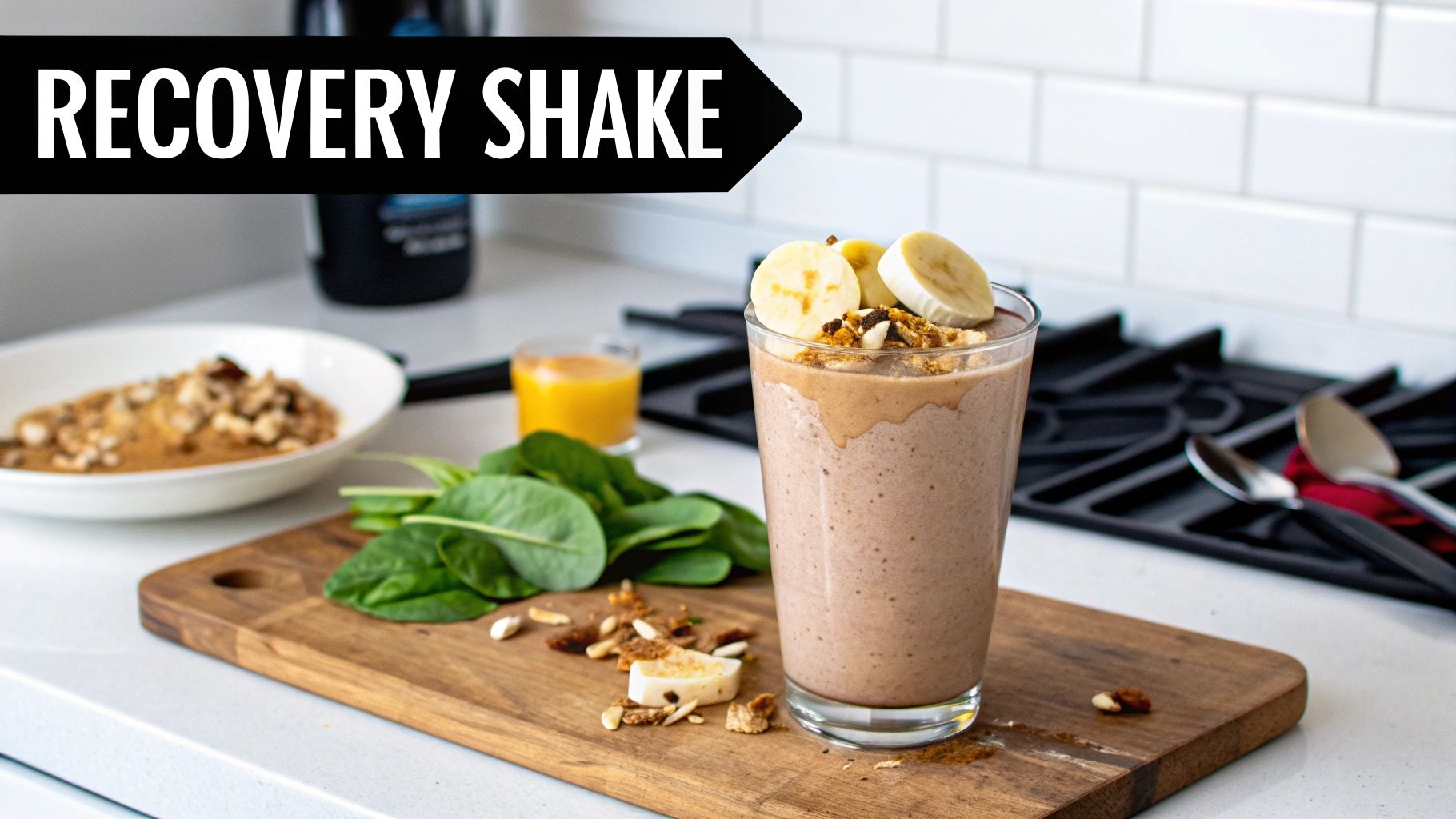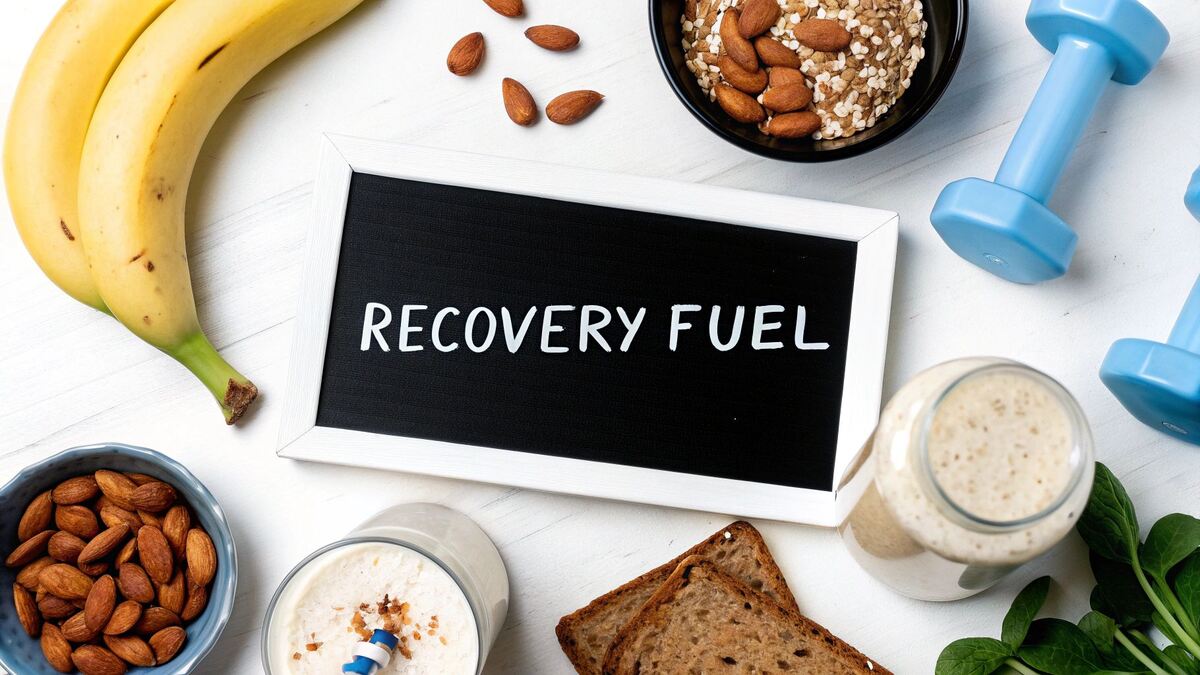8 Best Foods for Post Workout Recovery in 2025
Your workout doesn't end with the last rep; it ends with your recovery meal. What you eat in the crucial window after exercise can make or break your results, dictating how quickly you repair muscle, replenish energy stores, and reduce soreness. While the market is flooded with expensive supplements and complex formulas, the most powerful recovery tools are often found right in your kitchen. This comprehensive guide cuts through the noise to reveal the scientifically-backed best foods for post workout recovery, moving beyond generic advice to provide a strategic blueprint for your post-training nutrition.
We'll explore precisely why the combination of high-quality protein and smart carbohydrates is non-negotiable for anyone serious about their fitness goals, from men looking to gain muscle to women focused on weight management. Understanding these principles is key to optimizing your body's repair processes. To delve deeper into the metabolic processes involved, consider learning more about the food factor in post-exercise metabolism. Forget vague suggestions; this list provides actionable details on how specific macronutrients and micronutrients accelerate healing, transforming your effort in the gym into tangible, visible progress. It's time to build a recovery strategy that works as hard as you do.
1. Greek Yogurt with Berries
Greek yogurt paired with antioxidant-rich berries stands out as one of the best foods for post workout recovery due to its ideal macronutrient profile. The straining process used to make Greek yogurt removes most of the whey and lactose, resulting in a thicker, creamier product with nearly double the protein of regular yogurt. This high concentration of protein is crucial for initiating muscle protein synthesis, the process your body uses to repair and rebuild muscle fibers damaged during exercise.
Combining this protein powerhouse with the simple carbohydrates from berries helps to rapidly replenish depleted glycogen stores, your muscles' primary fuel source. This synergy between protein and carbs makes it a highly effective and efficient recovery meal. Its widespread adoption by elite athletes, from Olympic swimmers to professional tennis players like Novak Djokovic, underscores its effectiveness in demanding training environments.
Why It Works for Recovery
The "magic" of this combination lies in its nutrient timing and composition. Consuming a mix of protein and fast-digesting carbohydrates within the 30-60 minute "anabolic window" post-exercise can significantly accelerate recovery. The probiotics naturally present in Greek yogurt also play a vital role by supporting gut health, which enhances overall nutrient absorption and reduces inflammation.
This infographic summarizes the primary recovery benefits of a Greek yogurt and berry combination.

As the data highlights, achieving a high protein intake, an optimal carb-to-protein ratio, and gut-health support in one simple meal makes it a top-tier recovery choice.
Practical Tips for Your Post-Workout Meal
- Choose Plain Yogurt: Opt for plain, unsweetened Greek yogurt to avoid added sugars. A single serving can pack over 20 grams of protein.
- Time It Right: Consume your yogurt bowl within 30-60 minutes after your workout to maximize muscle repair and glycogen replenishment.
- Boost Your Carbs: For intense or long-duration workouts, add a tablespoon of honey or a sprinkle of granola for additional quick-digesting carbohydrates.
- Add Healthy Fats: Mix in a tablespoon of chia seeds or ground flaxseeds to incorporate anti-inflammatory omega-3 fatty acids.
This simple, powerful meal is a cornerstone of many athlete nutrition plans, including those featured in vegetarian meal plans. For more ideas on how to incorporate high-protein vegetarian options into your diet, you can explore various vegetarian meal plans on ai-mealplan.com.
2. Chocolate Milk
Chocolate milk has evolved from a childhood favorite into a scientifically-backed powerhouse, widely recognized as one of the best foods for post workout recovery. It naturally provides an optimal carbohydrate-to-protein ratio, typically around 3:1 or 4:1, which is ideal for replenishing muscle glycogen and initiating muscle repair simultaneously. The drink contains both whey and casein proteins; whey is fast-digesting to kickstart recovery, while casein provides a slower, more sustained release of amino acids.
Its effectiveness is supported by numerous studies, including landmark research from Indiana University that found it to be as effective as commercial sports drinks for recovery. This evidence has led to its adoption by high-performance organizations, with the US Olympic swimming team, various NBA franchises, and professional cycling teams all incorporating it into their official recovery protocols. Its convenience and affordability make it an accessible and highly effective option for athletes at all levels.
Why It Works for Recovery
The "magic" of chocolate milk lies in its perfect natural formulation. The simple sugars (carbohydrates) from the chocolate and milk rapidly restore depleted glycogen stores, while the high-quality dairy protein provides the essential amino acids needed for muscle protein synthesis. Additionally, it rehydrates the body and replenishes key electrolytes like calcium, potassium, and sodium that are lost through sweat during intense exercise.
The combination of these benefits in a single, easy-to-consume beverage makes it a remarkably efficient recovery tool. Its widespread use in collegiate and high school athletic programs nationwide is a testament to its proven ability to reduce muscle soreness and improve subsequent performance.
Practical Tips for Your Post-Workout Meal
- Optimal Timing and Amount: For best results, consume 16-20 ounces within the first 30 minutes after completing your workout.
- Choose Low-Fat Options: Select low-fat (1% or 2%) versions to get the ideal nutrient balance without excessive fat and calories.
- Keep It Convenient: Keep shelf-stable, single-serving boxes in your gym bag for an immediate and convenient recovery drink.
- Enhance for Intense Workouts: After a particularly grueling session, pair your chocolate milk with a banana to add extra potassium and carbohydrates.
- Check the Label: Look for brands with minimal added sugars and artificial ingredients to maximize the health benefits.
This simple, effective, and budget-friendly drink is a staple in many high-performance nutrition plans. For those building a diet focused on muscle gain, incorporating simple yet powerful recovery foods like chocolate milk is key. You can find more strategies for structuring your meals in various muscle gain meal plans on ai-mealplan.com.
3. Salmon with Sweet Potato
Salmon paired with sweet potato offers a powerful whole-food approach to post-workout recovery, combining high-quality protein and potent anti-inflammatory fats with complex carbohydrates. A single 4-ounce serving of salmon delivers approximately 25 grams of protein, essential for repairing muscle tissue, alongside a significant dose of omega-3 fatty acids (EPA and DHA) known for their ability to combat exercise-induced inflammation.

This potent protein and fat combination is perfectly complemented by the complex carbohydrates in sweet potatoes, which provide a sustained release of energy to methodically restore depleted glycogen stores without spiking blood sugar. This meal is a fixture in the nutrition plans of elite athletes, from NFL training tables to the regimens of endurance competitors like triathlete Mirinda Carfrae, highlighting its status as one of the best foods for post workout recovery.
Why It Works for Recovery
The effectiveness of this meal lies in its dual-action recovery support. The protein from salmon provides the essential amino acids needed for muscle protein synthesis, while the omega-3 fatty acids actively work to reduce systemic inflammation and muscle soreness. Simultaneously, the slow-digesting carbohydrates from the sweet potato ensure a steady replenishment of energy, promoting a more complete and sustained recovery process, making it ideal for a full meal 1-2 hours after training.
Practical Tips for Your Post-Workout Meal
- Choose Wisely: Opt for wild-caught salmon, as it generally has a higher concentration of omega-3s and fewer contaminants compared to farmed varieties.
- Cook for Health: Bake or grill the salmon instead of frying to preserve its delicate fatty acids and overall nutritional integrity.
- Prep Ahead: Cook a few fillets and sweet potatoes at the start of the week for quick and convenient post-workout meals.
- Enhance Nutrient Absorption: Drizzle the sweet potato with a little olive oil to improve the absorption of fat-soluble vitamins like Vitamin A.
- Portion Correctly: Aim for a 4-6 ounce serving of salmon with one medium-sized sweet potato to hit the ideal macronutrient ratio for recovery.
This nutrient-dense meal aligns perfectly with the principles of a heart-healthy diet. You can find more recipes featuring salmon and other beneficial whole foods in various Mediterranean meal plans on ai-mealplan.com.
4. Eggs with Whole Grain Toast
Eggs paired with whole grain toast create a classic, powerful combination that ranks among the best foods for post workout recovery. Eggs are often considered the gold-standard protein source, boasting the highest biological value of any whole food. This means your body can absorb and utilize nearly all of the protein they contain, making them exceptionally efficient for repairing muscle tissue damaged during intense exercise.
Combined with the complex carbohydrates from whole grain toast, this meal effectively replenishes depleted muscle glycogen stores. The synergy of high-quality protein and steady-release carbs provides a comprehensive recovery solution. This pairing has been a staple for decades in the diets of elite athletes, from bodybuilders like Arnold Schwarzenegger to powerlifters and professional cyclists who need sustained energy and robust muscle repair.
Why It Works for Recovery
The effectiveness of this meal lies in its complete nutritional profile. A single large egg provides about six grams of high-quality protein, including all nine essential amino acids necessary for muscle protein synthesis. The yolk, often discarded, is a nutritional powerhouse containing vital nutrients like vitamin D, choline, and healthy fats that aid in reducing inflammation and supporting overall metabolic health. The whole grain toast provides sustained energy without causing a rapid blood sugar spike.
This balance of macronutrients supports both immediate muscle repair and long-term energy restoration, making it an ideal choice within the post-workout window.
Practical Tips for Your Post-Workout Meal
- Go for Whole Eggs: Consume 2-4 whole eggs depending on your workout intensity and body size. Don't discard the yolks, as they contain many crucial recovery nutrients.
- Choose the Right Bread: Opt for 100% whole grain or whole wheat bread to ensure you're getting fiber and complex carbohydrates, not refined grains.
- Add Healthy Fats: Top your toast with sliced avocado for extra healthy fats, fiber, and potassium, which helps regulate fluid balance.
- Meal Prep for Convenience: Hard boil a batch of eggs at the start of the week for a quick and easy post-workout protein source.
- Enhance with Micronutrients: Add a handful of spinach or sautéed vegetables to your eggs for an extra boost of vitamins, minerals, and antioxidants.
5. Protein Smoothie with Banana and Nut Butter
A protein smoothie is an incredibly efficient delivery system for post-workout nutrition, making it one of the best foods for post workout recovery. This powerhouse combination of protein powder, banana, and nut butter provides a perfectly balanced mix of fast-acting protein for muscle repair, carbohydrates for glycogen replenishment, and healthy fats for sustained energy and reduced inflammation. Its liquid form ensures rapid digestion and absorption, making it gentle on the stomach when solid food might feel too heavy after a tough workout.
This method is a staple for elite athletes who require immediate and effective nutrient replenishment. NBA teams, for instance, have dedicated nutritionists who prepare custom smoothies for players post-game to kickstart recovery. Similarly, Tour de France cyclists often consume smoothies between stages to rapidly refuel their bodies for the next demanding ride, showcasing its effectiveness in high-performance environments.

Why It Works for Recovery
The effectiveness of a protein smoothie lies in its customizable and easily digestible nature. The protein powder, whether whey isolate for rapid absorption or a plant-based alternative, delivers essential amino acids directly to muscle tissues to begin the repair process. The banana offers a mix of simple and complex carbohydrates to quickly restore depleted glycogen stores, while the nut butter adds healthy fats and more protein, which helps to blunt the insulin spike and provide long-lasting satiety. This combination also contributes to essential rehydration.
Practical Tips for Your Post-Workout Meal
- Protein First: Use 1-2 scoops of your preferred protein powder (whey, casein, or plant-based) to ensure you get 25-40 grams of protein.
- Time It Right: For optimal results, consume your smoothie within 30 minutes after completing your workout to take full advantage of the anabolic window.
- Balance Your Macros: Add one medium banana and 1-2 tablespoons of nut butter (like almond or peanut butter) to create a balanced macronutrient profile.
- Boost Your Nutrients: Include a handful of spinach for extra vitamins and minerals without altering the taste. For more complex carbs after an intense session, add 1/4 cup of rolled oats.
- Get the Consistency Right: Blend all ingredients with one cup of a liquid like water, milk, or a plant-based milk alternative until smooth. Add ice for a colder, more refreshing texture.
6. Chicken Breast with Rice and Vegetables
The classic combination of chicken breast, rice, and vegetables is a cornerstone of athletic nutrition and one of the best foods for post workout recovery. This whole-food meal delivers a complete package of macronutrients and micronutrients essential for repairing muscle tissue and replenishing energy stores. The lean, high-quality protein from chicken breast provides the full spectrum of amino acids needed to kickstart muscle protein synthesis, directly addressing the micro-tears caused by intense exercise.
Paired with the carbohydrates from rice, this meal efficiently refills depleted glycogen levels, which is your muscles' primary fuel source. The inclusion of vegetables adds vital vitamins, minerals, and antioxidants to combat exercise-induced inflammation. This balanced, time-tested meal is a staple for a reason; its effectiveness is demonstrated by its widespread use among bodybuilders, professional NFL players in their training facilities, and Olympic athletes during competition prep.
Why It Works for Recovery
This meal's effectiveness comes from its clean, functional composition. The lean protein from chicken is highly bioavailable, meaning your body can easily absorb and utilize it for muscle repair. The carbohydrates from rice, particularly white rice, offer a quick source of glucose to replenish glycogen without the high fiber content that can slow down digestion post-workout. Vegetables round out the meal by providing micronutrients that support metabolic processes and reduce oxidative stress.
This video demonstrates a simple and effective way to prepare this essential recovery meal.
The meal’s simplicity and customizability make it an incredibly reliable and scalable option for anyone serious about their fitness goals.
Practical Tips for Your Post-Workout Meal
- Prep in Batches: Cook a large batch of chicken breast and rice at the beginning of the week to create several grab-and-go recovery meals.
- Choose the Right Rice: Opt for white rice for faster-digesting carbs immediately after a workout. Choose brown rice for meals later in the day to get more fiber and sustained energy release.
- Portion Correctly: Aim for a 4-6 ounce serving of chicken breast with 1 to 1.5 cups of cooked rice to achieve an ideal protein-to-carb ratio for recovery.
- Vary Your Veggies and Spices: Prevent flavor fatigue by using a variety of colorful vegetables like broccoli, bell peppers, and carrots. Experiment with different seasonings such as curry, teriyaki, or lemon-herb.
This meal is a foundational component in many nutrition strategies, especially those focusing on muscle gain and performance. To see how it can be integrated into a structured diet, you can explore various high-protein meal plans.
7. Tuna with Crackers or Rice Cakes
Canned tuna paired with crackers or rice cakes is one of the most convenient and affordable foods for post workout recovery. Its shelf-stable nature makes it a reliable protein source that can be stored easily in a gym bag, office drawer, or pantry. The high-quality lean protein in tuna provides the essential amino acids necessary for repairing muscle micro-tears and kickstarting muscle protein synthesis after strenuous activity.
Combining this potent protein with the fast-digesting carbohydrates from crackers or rice cakes helps to quickly replenish glycogen stores that were depleted during exercise. This powerful protein-carb combination is favored by a wide range of individuals, from professional bodybuilders like Jay Cutler who used it for contest prep to college athletes on a tight budget who rely on it as a protein staple.
Why It Works for Recovery
The effectiveness of this duo lies in its simplicity and nutrient profile. Tuna is naturally rich in anti-inflammatory omega-3 fatty acids, which can help reduce exercise-induced muscle soreness and inflammation. The combination of protein for muscle repair and simple carbs for energy restoration makes it a highly efficient recovery snack, especially when whole foods aren't immediately available.
This infographic summarizes the primary recovery benefits of a tuna and cracker combination.
As the data shows, its convenience, high protein content, and anti-inflammatory properties make tuna a practical and powerful recovery option.
Practical Tips for Your Post-Workout Meal
- Choose Wisely: Opt for tuna packed in water to avoid excess calories and fat. To minimize mercury exposure, choose "light" or skipjack tuna and limit consumption to 2-3 servings per week.
- Healthier Mix-ins: Swap traditional mayonnaise for Greek yogurt or mashed avocado to add extra protein and healthy fats.
- Boost Your Carbs: Pair with whole-grain crackers for added fiber or rice cakes for a quick, easily digestible carbohydrate source.
- Add Flavor: Enhance the taste without adding calories by mixing in lemon juice, fresh herbs, hot sauce, or spices.
This simple, budget-friendly meal is a mainstay in many fitness nutrition plans, especially for those seeking convenient, high-protein options. For more ideas on how to build a meal plan tailored to muscle gain, you can explore various muscle gain meal plans on ai-mealplan.com.
8. Cottage Cheese with Pineapple
Cottage cheese combined with fresh pineapple is a strategically effective choice among the best foods for post workout recovery, particularly for sustained, long-term muscle repair. Unlike whey, cottage cheese is primarily composed of casein protein, a slow-digesting protein that provides a steady release of amino acids to your muscles over several hours. This makes it an ideal food for preventing muscle breakdown long after your workout has finished.
Pairing it with pineapple adds a dual benefit. The pineapple provides fast-acting carbohydrates to begin replenishing glycogen stores, while also containing bromelain, a natural enzyme with powerful anti-inflammatory properties that can help reduce post-exercise soreness. This unique protein-enzyme combination has made it a staple for strength athletes and bodybuilders, including the legendary Arnold Schwarzenegger, who famously consumed it before bed to support overnight muscle synthesis.
Why It Works for Recovery
The primary advantage of this pairing lies in its two-speed recovery action. The simple sugars from the pineapple provide immediate energy replenishment, while the casein protein in the cottage cheese ensures your muscles receive a prolonged supply of building blocks for repair. This is especially beneficial when consumed before a long period of rest, such as overnight, as it continues to feed the muscles during the body's most regenerative state.
The bromelain in pineapple further enhances recovery by mitigating inflammation and swelling in muscle tissue. This enzymatic support can lead to faster recovery times and less delayed onset muscle soreness (DOMS), allowing for more consistent training.
Practical Tips for Your Post-Workout Meal
- Optimal Timing: Consume this snack 1-2 hours post-workout or, more ideally, about 30-60 minutes before bed to maximize overnight muscle protein synthesis.
- Choose Wisely: Opt for low-fat (1-2%) cottage cheese to get a high protein-to-calorie ratio. Select fresh or frozen pineapple over canned to ensure the highest bromelain content.
- Enhance with Fats: Mix in a small handful of walnuts or almonds for added healthy fats, which can further help reduce inflammation.
- Improve Texture and Flavor: If you dislike the texture, blend the cottage cheese until smooth. Add a dash of cinnamon or vanilla extract for flavor without extra sugar.
Top 8 Post-Workout Recovery Foods Comparison
| Item | Implementation Complexity 🔄 | Resource Requirements ⚡ | Expected Outcomes 📊 | Ideal Use Cases 💡 | Key Advantages ⭐ |
|---|---|---|---|---|---|
| Greek Yogurt with Berries | Low – no cooking, quick prep | Refrigeration, plain yogurt, berries | Muscle recovery, glycogen replenishment, gut health | Quick post-workout recovery | High protein & probiotics; ideal carb:protein ratio |
| Chocolate Milk | Very Low – ready to drink | Refrigeration, dairy milk, low-fat preferred | Rehydration, glycogen restoration, muscle repair | Post-exercise recovery drink | Research-backed, affordable, tastes good |
| Salmon with Sweet Potato | High – requires cooking (~25-30min) | Cooking tools, fresh salmon, sweet potatoes | Anti-inflammatory recovery, sustained energy | Whole-food recovery meal 1-2 hours post | Omega-3s reduce inflammation; nutrient-dense |
| Eggs with Whole Grain Toast | Medium – cooking needed | Cooking facilities, eggs, quality bread | Muscle protein synthesis, glycogen restoration | Post-workout meal within 2 hours | Highest biological protein value; versatile |
| Protein Smoothie with Banana and Nut Butter | Low – blender required | Protein powder, banana, nut butter, liquid | Fast absorption, muscle repair, glycogen restoration | Quick recovery when appetite low | Highly customizable, rapid nutrient delivery |
| Chicken Breast with Rice and Vegetables | Medium to High – cooking and prep | Cooking tools, chicken, rice, vegetables | Lean muscle building, glycogen replenishment | Meal prep, body recomposition focused | Lean protein, versatile, cost-effective |
| Tuna with Crackers or Rice Cakes | Very Low – no cooking | Shelf-stable canned tuna, crackers/rice cakes | Convenient protein boost, muscle repair | Portable snack or quick recovery | Shelf-stable, high protein, anti-inflammatory omega-3 |
| Cottage Cheese with Pineapple | Low – no cooking, little prep | Refrigeration, low-fat cottage cheese, pineapple | Sustained muscle protein synthesis overnight | Overnight recovery or secondary snack | Slow-digesting casein; bromelain reduces soreness |
Building Your Ultimate Recovery Plate
Mastering post-workout nutrition isn’t about finding one secret food; it’s about consistently applying the right principles. Throughout this guide, we’ve explored eight powerful options, from the immediate convenience of chocolate milk to the deep, sustained nourishment of salmon with sweet potato. Each serves as a fantastic template for one of the most crucial meals of your day.
The fundamental takeaway is the strategic pairing of high-quality protein with smart carbohydrates. Protein acts as the essential building block, initiating the repair of muscle fibers broken down during intense exercise. Simultaneously, carbohydrates work to replenish your depleted glycogen stores, refueling your energy reserves and preparing your body for its next challenge. This dynamic duo is the cornerstone of effective recovery.
From Theory to Action: Personalizing Your Plate
Your next step is to move from knowledge to application. The best foods for post workout recovery are ultimately the ones that fit your lifestyle, budget, and specific fitness goals.
- For On-the-Go Refueling: If you have a short window between your workout and your next commitment, a protein smoothie or Greek yogurt with berries offers a fast, digestible, and highly effective option.
- For Substantial Meal Recovery: When you have more time (1-2 hours post-exercise), a whole-food meal like chicken breast with rice or eggs on whole-grain toast provides a more complex and satiating recovery experience.
- For Muscle Gain: Prioritize higher protein and carbohydrate combinations, such as the salmon and sweet potato meal, to create the caloric surplus needed for muscle hypertrophy.
- For Weight Management: Focus on lean protein sources like cottage cheese or tuna and pair them with nutrient-dense, high-fiber carbohydrates to promote satiety without excess calories.
Beyond focusing solely on recovery, understanding how individual food choices fit into a broader healthy diet is crucial. For instance, many protein-rich foods and complex carbohydrates ideal for post-workout repair also serve as excellent healthy snacks that can also aid in weight management.
Your Recovery, Your Results
Ultimately, optimizing your recovery is about giving your body the tools it needs to adapt and grow stronger. By consistently refueling with the right nutrients, you’re not just reducing soreness; you are accelerating your progress, improving future performance, and building a more resilient, capable body. Listen to your body, experiment with the options we’ve discussed, and build a routine that feels both effective and enjoyable. This consistency is what transforms good workouts into great results.
Ready to eliminate the guesswork and build a perfect recovery plan tailored to your unique goals and preferences? The AI Meal Planner creates a personalized, nutritionist-backed meal plan in seconds, ensuring every post-workout meal is optimized for your success. Start building your custom plan today!
AI-powered nutrition
Get Your Personalized Meal Plan
AI creates the perfect meals for your goals, lifestyle, and taste.
Start Your Journej
